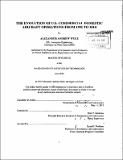The evolution of U.S. commercial domestic aircraft operations from 1991 to 2010
Author(s)
Wulz, Alexander Andrew
DownloadFull printable version (13.67Mb)
Alternative title
Evolution of US commercial domestic aircraft operations from 1991 to 2010
Evolution of United States commercial domestic aircraft operations from 1991 to 2010
Other Contributors
Massachusetts Institute of Technology. Dept. of Aeronautics and Astronautics.
Advisor
Peter P. Belobaba.
Terms of use
Metadata
Show full item recordAbstract
The main objective of this thesis is to explore the evolution of U.S. commercial domestic aircraft operations from 1991 to 2010 and describe the implications for future U.S. commercial domestic fleets. Using data collected from the U.S. Bureau of Transportation Statistics, we analyze 110 different aircraft types from 145 airlines operating U.S. commercial domestic service between 1991 and 2010. We classify the aircraft analyzed into four categories: turboprop, regional jet, narrow-body, and wide-body. Our study consists of three parts. First, we compare the four aircraft classes and explore trends in available seat miles, revenue passenger miles, load factor, aircraft departures, average stage length, aircraft utilization, seat capacity, daily departures per aircraft, aircraft ground time, and fuel burn. Second, we examine each of the aircraft classes in detail and provide insights on specific aircraft types. Finally, we compare product offerings from competing aircraft manufacturers in both the regional jet and narrow-body aircraft classes. The results indicate that more than 150 wide-body aircraft have been shifted from the U.S. commercial domestic market to international service while narrow-body stage lengths have increased 50% over the 20 year period analyzed. In addition, the introduction of more than 1,390 regional jets in the late 1990s and 2000s allowed airlines to expand hub operations and increase frequency on routes between major cities. A 10% decline in the turboprop fleet coupled with the lack of turboprop replacement aircraft in the 30 to 50-seat category suggest a potential for future reductions in air service to some smaller cities. Lastly, increasing fuel prices threaten the growth of the U.S. commercial domestic fleet in the upcoming decade and could potentially cause a significant number of aircraft to be no longer economically viable.
Description
Thesis (S.M.)--Massachusetts Institute of Technology, Dept. of Aeronautics and Astronautics, 2012. Cataloged from PDF version of thesis. Includes bibliographical references (p. 89-91).
Date issued
2012Department
Massachusetts Institute of Technology. Department of Aeronautics and AstronauticsPublisher
Massachusetts Institute of Technology
Keywords
Aeronautics and Astronautics.